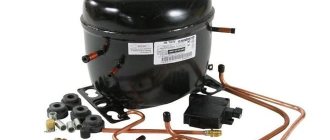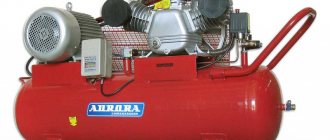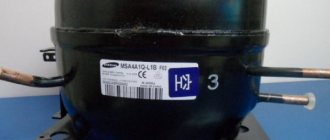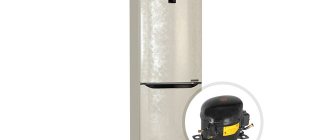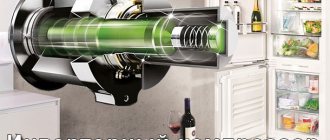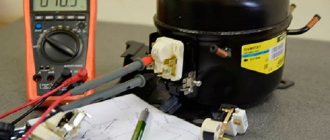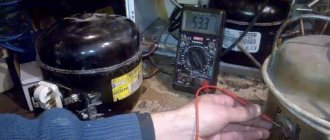What type of compressor do you prefer?
Segmenting compressors by type depending on the design also helps to make the right choice for inexperienced users. Models that are positioned as cars are suitable for most household needs - from painting surfaces to inflating rubber mattresses. A piston unit, which is used by both workers in workshops and ordinary car owners, can be a win-win solution. If the question is about what kind of compressor is needed for professional pneumatic tools, then you should pay attention to helical and belt models. Such devices usually have the highest power ratings and maintained pressure levels.
Which impact wrench should I choose for tire fitting?
The most important factors here are:
- maximum torque
- price-quality ratio
For example, the most optimal price-quality ratio today is the ROSSVIK RT-5268 impact wrench, but if you are looking more at the service life of the impact wrench, then feel free to choose impact wrenches from the HANS
, which will last at least 5 years.
In tire shops, where you loosen hundreds of nuts a day, pace of work is important. The higher, the greater the maximum torque of the impact wrench, the more efficient your work
.
Additional equipment – what to consider?
Buying just one compressor does not mean that the connection to the instrument will be configured correctly and the work will be done perfectly. Technological organization of the process often involves the introduction of special hoses, adapters and clamps. As practice shows, even light pneumatic tools, when connected to a compressor, require the use of clamps with suitable dimensions. You should not ignore personal protective equipment. If the compressor for pneumatic tools will provide spraying of abrasive materials, then you need to take care of protective headphones, gloves and goggles. To work with paints and varnishes, it is also recommended to purchase overalls that will provide protection from chemically unsafe substances.
Impact sockets for impact wrench
To work with threaded connections, nuts and bolts, the tool uses socket heads. They are fixed in a chuck or on a spindle and transmit torque to the fastener. Standard heads have a cylindrical shape with a square or polygonal recess.
The main difference between a pulse impact head and a basic one is the presence of a through hole for the pin. The presence of an additional hole is necessary for attaching to an impact wrench, which is used in work with increased loads and is capable of unscrewing tight fasteners.
Dimensions and design features
In addition to technical and operational characteristics, it is important to take into account such properties as mobility and size. For example, if you mean working with a spray gun to paint a fence, then you need to turn to lightweight and ergonomic devices. Even if they provide a low level of performance, it is more likely to be sufficient for normal operations. Such models, namely, include a coaxial compressor for pneumatic tools. The choice in this direction can also be oriented towards oil-free equipment, which does not have a receiver at all, but benefits from compactness. If you need a powerful and efficient compressor with a powerful housing, then it is recommended to get models equipped with comfortable handles and wheels.
Top pneumatic impact wrenches
| Toptul KAAG 1206 weighs about 800 grams and the case length is 150 mm. This model is perfect for operations in cramped spaces and hard-to-reach places. The ergonomic handle with a non-slip coating fits comfortably in the hand. A 3/8″ seat square and a tightening torque of 81 Nm are sufficient to work with nuts up to M10 in size. The high speed (up to 11,000) makes this model very productive. Air consumption is only 50 liters, which makes it possible to connect to inexpensive portable compressors. |
| The “half-inch” model FORCE 82542 is in steady demand in impact wrench stores. This is a good choice for a car mechanic, since the tightening force of 813 Nm is enough to unscrew the hub wheels, as well as most threaded connections in the car. The tool is well balanced and weighs only 2.56 kg, so it is convenient for long-term work from any position. |
| FORCEKRAFT NC-6218 is a powerful model with a 3/4-inch socket fit. A tightening torque of 2000 Nm is sufficient to dismantle rusty threaded connections up to M27 in diameter. It is worth noting that the gun weighs more than 9 kg, so it is not suitable for long-term continuous use. To make it easier to hold, an additional handle is provided. |
| The two-handed air impact wrench FORCE 82585 is a purely professional tool designed for the repair of heavy-duty and agricultural equipment, use on assembly lines and in construction. The long spindle with an inch-square fit is suitable for loosening large, deeply hidden bolts and nuts. The maximum force of 2439 Nm is enough to tighten fasteners up to M30 in size. When purchasing, you should take into account the increased requirements for the compressor, since this pneumatic tool consumes 255 liters of air per minute, and its operating pressure is 6.5 bar. |
Compressor manufacturers
In fact, every manufacturer of construction or industrial equipment contains compressors for various purposes in their line. If we talk about Russian companies working in this direction, then “Caliber” and Elitech come to the fore. The products of these brands may not always be able to compete with the best foreign models, but in terms of cost they are the most profitable acquisition. In general, the question of how to choose a compressor for pneumatic tools with the highest level of properties should be solved with the help of foreign products. The range in this sector is quite wide, but the brands Fubag, Metabo, Senco and others enjoy great confidence among professionals.
How to choose a compressor for pneumatic tools?
Compressor
is an essential component for most models of pneumatic tools.
Such equipment is used both in private households and in specialized workshops. There is also a separate category of industrial equipment, the representatives of which also require the connection of compressors. The abundance of pneumatic units makes it difficult to select additional components, but if equipped correctly, the user can count on a high-quality result during the work process. The question of how to choose a compressor
for a pneumatic tool, naturally, first implies mention of functionality, reliability and durability. But even compliance with these features does not always provide the expected effect from using the tool.
READ How to Cut Corners of Ceiling Plinths with a Miter Box Video
Basic selection options
An experienced technician evaluates compressors based on three main features, including pressure level, performance and receiver volume. Regarding the first aspect, the initial indicator is 6 bar. This is the low pressure value available to the compressor for pneumatic tools designed to perform light household operations. Models with a pressure level of 10-15 bar are also common. This equipment is capable of working with more demanding units, including those from the industrial sector.
The performance of compressors is expressed in liters of working mixture sprayed per minute. So, for small-scale painting projects, 10-50 l/min is enough. But this range can be expanded to 500 l/min if we are talking about using the equipment in a workshop. The volume with which a compressor for pneumatic tools for household use is on average 7-10 liters. Naturally, there are more capacious receivers, but most of them are used in highly specialized areas.
How to choose a pneumatic impact wrench
If the tool is supposed to be used stationary in a garage, then auto mechanics prefer a pneumatic impact wrench. You can choose the right model only based on its parameters.
First of all, pay attention to the presence of an impact mechanism in the pneumatic impact wrench. It helps to remove a stuck or rusted nut from its place. To deal with one piece of hardware, an air impact wrench will take about 5 seconds. The tool is in demand in auto repair shops, tire service stations, auto repair plants and other places where there is a need. The impact mechanism helps to cope with large-sized hardware. The presence of reverse allows you to unscrew and tighten the nuts with a pneumatic wrench.
Black heads are best for impact instruments
Advice! It is optimal to choose black heads for an air impact wrench. They are made of hardened steel, which better withstands loads. If there is no impact function, you can choose classic white heads.
The impact mechanism allows you to tighten the hardware with maximum force. After using a pneumatic impact wrench, manual tightening with wrenches is not required. If there is no impact function, a person will have to perform a control tightening of the hardware manually using keys.
The next important parameter is the rotor rotation speed. Not to be confused with torque, which determines power. The force of a pneumatic impact wrench with an impact function increases with the rotation speed, but this parameter has a greater effect on the operating speed. High-speed models with a maximum speed of up to 8 thousand rpm are considered professional. They are optimally chosen for large volumes of work.
Important! If an impact wrench is used incorrectly at high speed, there is a risk of stripping the threads of small hardware.
Torque is precisely the parameter that determines power. If you use a weak air impact wrench during operation, the nuts will not be tightened properly. Over time, under load, the fasteners will weaken. Choosing an impact pneumatic tool that exceeds the recommended power can result in overstressing the threads. Over-tightened hardware will collapse over time.
A professional air impact wrench can have an output force of up to 10,000 Nm
Tire service stations and car repair shops use pneumatic impact tools with a minimum torque of 100 Nm. For household use, it is better to choose less powerful models. If you need to choose a pneumatic impact wrench for trucks or large agricultural equipment, then preference is given to impact models with high torque, for example, from 5000 to 10000 Nm.
The size of the spindle depends on the power of the impact wrench. The greater the torque, the larger the assembly. For example, for hardware with a thread diameter of 25-35 mm, an inch-sized spindle is required, and from 35 to 50 mm a 1.5-inch spindle is suitable.
When choosing a pneumatic impact wrench, you need to ensure compressor compatibility, otherwise the tool will quickly fail. The optimal parameter is considered to be when the operating pressure of compressed air in the compressor tank exceeds that of the pneumatic tool by 2 bar. The compressor performance should be 1.3 times higher than the air consumption of the impact wrench.
Less important parameters are the manufacturer, the design of the pneumatic tool, and cost. Here the consumer just needs to choose the model he likes at his discretion. It would be a good idea to read user reviews about pneumatic impact wrenches and ask experienced auto mechanics for advice.
The video shows tips to help you choose a successful pneumatic impact wrench:
What kind of compressor is needed for a pneumatic impact wrench?
Selecting a compressor and pneumatic tools
When you're choosing a compressor, bigger won't always mean better. This is because not every job will require a very large receiver and the highest performance. Below we present the nominal operating values of pneumatic tools, which will help you choose a device for you so that it does not wear out or, on the contrary, does not use energy in vain.
Using this table, you will calculate which tools will require equipment that produces 8 bar, and which ones will need more. When choosing, take into account pressure surges that occur, as well as leaks in the lines. That’s why choose a device that has supplies.
Operating voltage and frequency
Operating voltage and frequency
The equipment can be three-phase or single-phase. In most cases, three-phase models will not be suitable for home use. Three-phase power is not available in every home. There is only one piece of advice here: you need to select a compressor that will match your home voltage and frequency. The choice of frequency is easier, because a single frequency standard has been adopted - 50 Hz. But, when purchasing, it would be useful to check the operating voltage and frequency in the passport to be sure that after purchasing the device it will perform its duties normally and smoothly.
Unit types
Many people are satisfied with small-sized models without receivers. compressor is suitable here
for pneumatic tools. Most devices require a pressure of more than 6 atm, and a spray gun is suitable for 4 atm. With all this, you can adjust the reducer to the required pressure.
For domestic use, powerful equipment is not required. A compressed air supply can be made into a receiver, but filling it takes time. The performance of the unit and the volume of the storage tank are selected for a specific set of pneumatic tools for the compressor.
What are the main parameters for selecting a tool?
Air flow. This line is analogous to power for a power tool and indicates how many hp. The instrument needs air per conventional unit of time for normal operation. For most pneumatic rotary tools and spray guns, it is indicated as the flow rate of liters. in a minute. For pneumatic staplers and nailers that operate on the impact principle, this feature is indicated as the consumption of liters. for a shot. This is due to the fact that the energy of compressed air is spent only on the forward and reciprocal movements of the piston.
READ Which Compressor Is Needed For A Impact Wrench
In both of the above cases, we can assume that the higher the air flow indicated on the tool, the stronger the tool itself. The other side of the coin is that for its own operation, such a pneumatic tool will require a more efficient compressor to ensure a measured and uninterrupted supply of compressed air.
Operating pressure. This characteristic can be compared with the voltage in the electronic network for a power tool. If it is designed for a 220v network, then at the lowest voltage, the electric motor may simply not start. So in the case of pneumatic tools, if the operating pressure is very low, then the nailer will not finish the nail or will not shoot at all, and the wrench will not produce the indicated tightening torque.
Note: If the network voltage is less than required, the motor of the power tool may fail. A pneumatic tool does not have this drawback - it simply will not work. However, with excess pressure, there is a high risk of damage to the moving parts of pneumatic tools and rubber seals.
You can familiarize yourself with the approximate parameters of pneumatic tools in the table below in order to get an idea of what type of tool consumes how much. See the annotation for each pneumatic tool for clear numbers.
Belt compressor
Direct drive in the form of a belt drive from the motor to the piston group makes it easy to start the compressor
for pneumatic tools in the cool season and has a fairly long service life. Reviews say that the unit performs well in extremely dusty air and other extreme conditions. The piston group operates at low speeds and heats up less.
The receiver capacity for household use and short-term work is 24-50 liters.
COMPRESSOR FOR WRENCH - SELECTION AND OPERATION
Before selecting an industrial compressor for an impact wrench, you need to decide on the pneumatic impact wrench itself. The most important technical characteristic of a pneumatic impact wrench is torque. The amount of torque directly affects the nature of the operations that can be performed using a given impact wrench, as well as the time it takes to complete them. Obviously, the higher the torque, the more you can tighten the threaded connection (or, conversely, unscrew a “stuck” nut). But on the other hand, using an overly powerful impact wrench can lead to damage to the threaded connection (thread breakage). Therefore, it is very important that the torque matches the specifics of the tasks being solved.
If we give a numerical estimate of the torque parameters, then for pneumatic impact wrenches it lies in the range from several tens to several thousand Nm. An impact wrench intended for solving household and semi-professional tasks must have a torque value from 200 Nm to 600 Nm. For more serious work, impact wrenches with a torque of 1000 Nm and above are required.
The second important technical characteristic of the wrench – the seat size of the square (spindle) – also depends on the magnitude of the torque. Everything is simple here: the higher the torque, the larger the size of the square. The standard range of sizes for square shanks are measured in inches. The most common spindle sizes are ½, ¾ and 1 inch. As a rule, to solve household and semi-professional tasks, wrenches with a ½-inch square are used, and in industry with ¾- and 1-inch squares.
You can consider the issue of choosing the size of the spindle square from the other side. According to impact wrench manufacturing companies, the size of the square is related to the size of the nut (bolt head) that needs to be unscrewed/tightened: - if the turnkey nut size is from 10 to 21 mm, then a wrench with a ½ inch square is suitable; — if the turnkey nut size is from 24 to 36 mm, then a ¾-inch square wrench will do; — if the turnkey nut size is 41 mm or more, then a 1-inch square wrench will do.
The third important technical characteristic of a wrench is air flow. It also depends largely on torque: the higher the torque, the greater the air flow. Impact wrenches with a ½-inch square size have an air flow of 150-250 l/min; for more powerful impact wrenches from 300 l/min and above.
As an example, we give a summary table of the main technical characteristics of impact wrenches from one of the world's well-known manufacturers of these products.
| Name of product | Torque, Nm | Air consumption, l/min |
| Impact wrench ½" | 270 – 810 | 170 – 230 |
| Impact wrench ¾" | 680 – 1600 | 270 – 340 |
| Impact wrench 1″ | 1630 – 4070 | 800 – 1130 |
General approaches to compressor selection
After choosing a wrench, proceed to choosing an air compressor. The compressor to which the impact wrench will be connected must meet two requirements: - provide the required operating pressure of compressed air; — ensure the required compressed air flow.
The standard operating pressure required for most impact wrenches on the market is 6.2-6.5 bar. Therefore, the compressor that is planned to be used for operation must have a maximum operating pressure of 10 bar (or, in other words, operate in a pressure range of 8-10 bar).
How to choose a compressor for a service station based on performance? The driver's data sheet indicates its air consumption. However, in practical work, the impact wrench is not used constantly, but with certain breaks. Therefore, each pneumatic tool (including the impact wrench) has its own so-called utilization factor. In our case, it is 0.2-0.25. Therefore, if the impact driver’s passport indicates that its air flow is 300 l/min, then for real calculations it is necessary to take into account the value of 60-75 l/min.
If you plan to use several impact wrenches, then it is necessary to take into account the likelihood of their simultaneous operation. It is determined by the equipment synchronicity coefficient, the values of which are given in the table.
| Number of compressed air consumers | 1 | 2 | 3 | 4 | 5 |
| Equipment synchronism factor | 1,0 | 0,95 | 0,91 | 0,87 | 0,84 |
Thus, the previously calculated value of the total compressed air consumption must be multiplied by the corresponding synchronism factor. And based on the obtained value, select a production air compressor.
The further procedure for selecting a compressor is exactly the same as when choosing it to connect any other equipment. There are two types of compressors: piston and screw. If the air flow rate is up to 1000-1200 l/min, then a piston compressor can be used; if higher, it is better to use a screw compressor.
On the other hand, the choice of compressor type also depends on the nature of the work: if it is one- or two-shift, then a piston compressor is quite suitable; If the operating mode is 24 hours a day, then a screw compressor is needed.
Issues of practical operation of the impact wrench
The first question that arises most often is what quality of compressed air is needed to operate a pneumatic impact wrench? If your production facility has the opportunity to use dry compressed air to power the impact wrench, that’s great. If this is not possible, then you can do without a refrigerated dryer. In this case, it is enough to install a filter-moisture-oil separator with a built-in pressure regulator and a lubricator into the pneumatic line. The moisture-oil separator filter will remove moisture, the regulator will provide the required compressed air pressure, and the lubricator will lubricate the impact wrench.
By the way, if in production it is possible to provide the impact wrench with dry compressed air, then it is still necessary to install an air preparation unit in front of it. In this case, it includes a pressure regulator and a lubricator.
The next question concerns the installation of an air preparation unit in the pneumatic line. Whatever the geometry of the pneumatic line, there are two main ways to install air preparation units into it: above the main pipe and below the main pipe.
What is good about installing the block above the pipe? In this case, the upward vertical outlet, to which the air preparation unit is then attached, naturally prevents condensate from entering the unit. If the block is installed under the main pipe, then in this case a vertical outlet is made from the pipe downwards, into which a tee is cut, and from this tee the block is connected through a separate pipe. And in order to prevent the block from being “flooded” with condensate, the vertical outlet from the main pipe is continued even lower, and ends with a tap for removing condensate.
In both cases, the connection of the air preparation unit to the pneumatic line is made through a shut-off ball valve. This will allow, if necessary, to quickly disconnect the unit from the pipeline.
Most air preparation units are equipped with a Y-shaped connector, which makes it possible to connect two impact wrenches to them at once. And to ensure high-quality lubrication of the impact wrench, the length of the flexible hose should not exceed 5 meters. Select a compressor for a wrench
Return to list
Screw compressors
The increase in air pressure is created by two high quality steel rotors placed in a housing. Oil and air enter the rotor mechanism, after which the flows are separated. The installation contains a complex structure and an electronic control system, due to which it has a high cost. It is mainly used by professionals when the question arises about which compressor to choose for pneumatic tools. Reviews appreciate the screw models, their compactness, low vibration and durability.
The device is equipped with an air cooling system, which allows heating the premises during operation. Working pressure reaches 15 atm.
Operating rules
Once the choice has been made which compressor
needed for a pneumatic tool, you still need to be able to operate it.
To do this, you must follow the following rules.
- Maintain the tightness of all assembly units.
- Periodically inspect valves, measuring instruments and check the serviceability of automation.
- Clean the air filter mesh when clogged and periodically. no less than 50 days later.
- The oil level in the crankcase should be replenished. It is checked through a transparent window at the bottom of the case. The breather opens and oil is poured through the oiler or funnel to the required level.
- Condensate should be drained from the receiver regularly so as not to expose the metal of the tank and exhaust tract to corrosion.
- As they wear out, the connecting rod bearings must be tightened, and after complete wear, the bearings must be replaced.
- If water gets into the oil, it should be replaced.
- When connecting the engine, the power of the electrical network must correspond to the load of 1-2.5 kW.
READ Which Compressor For A Jackhammer
Unit types
Many people are satisfied with compact models without receivers. compressor is suitable here . Most devices require a pressure of at least 6 atm, and a spray gun is suitable for 4 atm. In this case, you can adjust the reducer to the desired pressure.
For domestic use, powerful equipment is not required. A supply of compressed air can be created using a receiver, but it takes time to fill it. The performance of the unit and the volume of the storage tank are selected for a specific set of pneumatic tools for the compressor.
Unit selection
First of all, the set of pneumatic tools for the compressor and its features are taken into account, where each device requires a certain air flow and pressure.
When calculating the productivity Q of a device, the performance characteristics of the tools and their number are determined. The calculation is made using the formula:
where Q1 is the productivity of the tool, K1 is the utilization factor. 30% of the productivity reserve is added to the calculated value.
If the tool is designed for a pressure of 6-7 atm, the unit is selected for 8-9 atm, since the pressure in the system fluctuates within 2 atm. As wear occurs, the air compression force begins to decrease, which reduces the power of the unit.
For long-term work you need a large volume receiver. Professionals use tanks with a capacity of up to 500 liters. When the pressure in them exceeds the norm, the electric motors are switched off via a pneumatic relay, which prevents overloading of the equipment. The pressure for pneumatic tools is set using a gearbox.
What compressor
Is it better for pneumatic tools? Even knowing the answer to this question does not mean that you should choose a device with a large receiver and high performance. For normal operation, equipment should not wear out or waste energy.
A unit with a pressure of 3-4 atm is suitable for a paint sprayer, for a drill – 6 atm, for a sandblasting gun – 8 atm. Everywhere you need a small reserve of 2 atm, which is associated with instability and equipment wear.
Compressor
is a source of compressed air for pneumatic tools.
The purposes for using the device can be very diverse. Therefore, it is important that its technical characteristics correspond to the conditions of the upcoming work. The most common compressor
for pneumatic tools.
How to choose a pneumatic impact wrench for a compressor
Air flow and operating pressure
Before choosing an air impact wrench, carefully look at the characteristics of your air compressor in order to select the correct air impact wrench for the compressor. It is assumed that the average air compressor should produce 30%-50% more air than the entire connected tool consumes. For example, if a pneumatic impact wrench consumes 150 l/min, then it will work optimally with a compressor that produces about 200-225 l/min. As a rule, most models operate with an air pressure of 6.3 BAR, but there are impact wrenches with an operating pressure of 8.4 BAR. Some angle pneumatic impact wrenches (pneumatic ratchets) operate with a pressure of 3 BAR. The technical description of the pneumatic impact wrench indicates its operating pressure and the amount of air consumed.
As a general rule, the larger the compressor's air reservoir, the longer it will run, since a larger air reservoir will be depleted less often than a smaller reservoir, meaning the compressor motor will not be constantly running, pumping air non-stop.
Drive shaft speed
Otherwise found as rotation speed, measured in the number of revolutions of the working shaft made per minute without load. The higher the rotation speed, the faster the air impact wrench works. Almost always, higher performance of this parameter means lower torque from the impact wrench. Most people prefer to focus on the maximum torque value rather than the shaft speed.
Case Features
Type of shell
Pneumatic impact wrenches are divided into:
- Pistol;
- Corner
- Direct.
Pistol housings have impact wrenches with a connecting square from 1/4 to 3/4 inches. Can be used with one hand. Pistol body impact wrenches are the most popular.
Angled models have low torque, so they are used for working in hard-to-reach places, for example, in the engine compartment of a car.
Straight models have high torque characteristics and decent weight, as they must unscrew large threaded connections. Such impact wrenches have a connecting square of 3/4 inch or more. Due to the weight, each straight impact wrench model is equipped with an additional handle, so operation will require the use of both hands of the operator.
Housing material
The impact wrench can have a metal, aluminum or composite body.
Pneumatic impact wrenches with a metal and aluminum body are more resistant to careless use, such as falls, and are resistant to dirt or accidental collisions with cars. Of course, such models weigh more than impact wrenches with a composite body. Most models have a rubberized casing.
Due to the use of composite materials, the weight of the impact wrench is significantly reduced, but such models are more susceptible to external contamination and are sensitive to careless use.
Case size
A physical characteristic of a wrench that affects the ability to use the tool in hard-to-reach places. Typically, smaller impact wrenches have less torque.
The smaller the tool, the better it works in hard-to-reach places. The downside is that smaller models have less torque. This is a “slim” choice in which you will find a tool with the size and power you need.
Additional handle
Found in impact wrenches with a connecting square of 3/4 and 1 inch. The presence of an additional handle is due to the large weight of the tool.
Drive shaft length
There are models with both short and extended working shafts. The presence of an extended shaft makes it possible to work with fasteners that are recessed in hard-to-reach places, for example, in the steel rim of a cargo wheel. As a rule, powerful air impact wrenches for trucks have an extended spindle.
Power adjustment
The presence of speeds allows you to control the output torque of the air impact wrench. Thus, using different speeds depending on power needs will help loosen or tighten threaded connections without damaging them. The number of speeds for unscrewing and tightening depends on the specific model of the impact wrench and is indicated in the description of the product card or shown in a separate picture. It is also worth paying attention to the reliability and convenience of the location of the speed switch.
Weight
There are models with different weights. For short-term use, weight is unlikely to be an important factor, but for long-term work, where fatigue inevitably sets in, it would be better to choose a lighter air impact wrench. Over long periods of use, a lighter impact wrench places less strain on the wrist, resulting in operator fatigue later.
Ergonomics and reverse switch
The ergonomics of the tool plays an important role when choosing a pneumatic impact wrench. Choose a wrench that fits your hand, has a comfortable grip, and is well balanced to reduce fatigue and strain during use.
The reverse switch must be located on the impact wrench body in such a way that it is possible to quickly switch the direction of rotation of the working spindle.
Equipment
Some models come in a plastic case along with popular impact socket sizes, extensions, fittings and lubricator. The plastic case makes it easy to store, and the set is cheaper than buying all the components separately.
Warranty, service center and availability of spare parts
Check the warranty period and availability of spare parts: rotor blades, spindles and other repair kits. Pay attention to the presence of a service center, since a serious and responsible company not only sells, but also maintains the equipment sold, both warranty and post-warranty.
For most models of AIST
Spare parts are available, and missing parts can most likely be ordered from the manufacturer. AIST also has its own service center, which repairs and maintains tools.
Country of Origin
Most models of pneumatic impact wrenches presented on the Russian market are produced in factories in mainland China and island Taiwan. Taiwanese air impact wrenches differ from their Chinese counterparts in the following:
- Made from quality materials;
- Have reliable internal mechanisms;
- Neatly assembled and free of loose parts and gaps;
- Resistant to long-term loads;
- Develop the declared power;
- With proper operation, they ensure a long period of maintenance-free use.
All models of AIST
and
MASTER
are manufactured on modern high-tech production lines of factories in Taiwan.
Price
In general, the cost of a tool depends on all of the listed parameters, but the most important characteristic when choosing a pneumatic impact wrench is the maximum torque. Once you've narrowed down your choices based on the torque you need, you can look at other options by comparing the differences between specific models.
Principle of operation
The work cycle includes only 2 piston movements. When it moves, a vacuum is created and air is sucked into the working cylinder. During the reverse stroke it compresses. At the same time, the suction valve closes, and the discharge valve opens, allowing compressed gas to flow into the main line.
The disadvantage of the units is the pulsed supply of a gaseous medium. To equalize pressure, receivers are used, which are also energy storage devices. A safety valve is connected to them to relieve excess pressure.
Sources:
https://stankotec.ru/raznoe/kakoj-nuzhen-kompressor-dlya-pnevmoinstrumenta-instrumenty-vybiraem-kompressor-dlya-pnevmoinstrumenta.html https://www.syl.ru/article/315263/kompressor-dlya-pnevmoinstrumenta -osobennosti-vyibora-vidyi-i-otzyivyi

